I have started gathering information from actual witnesses about the changes and developments which have taken place in this summer capital since the beginning of the war. The people of Baguio first came to know about the war when the Japanese planes dropped bombs over this city in the early morning of December 8. When attacks were reported on the following day and the days after, the people closed all stores and market places and fled terrified to nearby caves and forests.
Meanwhile, most of the USAFFE troops stationed in Baguio were sent to defend Pangasinan and La Union when the Japanese forces first landed. The others fled to Bontoc when the first wave of enemy troops showed up along Bauang road on December 24. Nobody was around to turn the town over to the enemy. It was done by the Mayor and the Chief of Police.
On the twenty-seventh of December, the first fifty Japanese entered without firing even a shot, just as they had done in all other towns of the Philippines. Manaoag was “conquered” by five bicycle-riding Japanese.
The take-over was peaceful. The only blunder was the novel idea which occurred to the military chief to organize a parade celebrating the fall of Singapore. He ordered everybody to join, including the members of religious congregations. It was a tragi-comic sight to see cloistered nuns, American Dominicans of the Maryknoll Convent, Spanish, Belgian, German and Irish priests and sisters, parading through the streets carrying small Japanese flags and waving them every time the Japanese shouted: “Banzai! Banzai! Nippon!”
The Japanese town chief did not understand anything about canon law nor international law. On Sundays he came to Mass. He was not a Catholic. He demanded to be given a special seat at the altar, and after the Mass he preached on the gospel of the Co-Prosperity Sphere.
